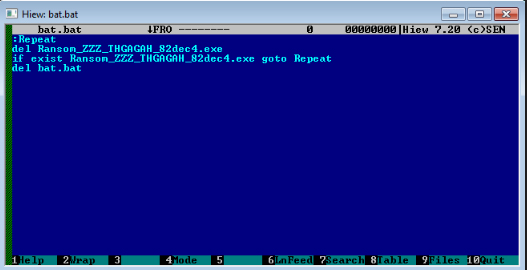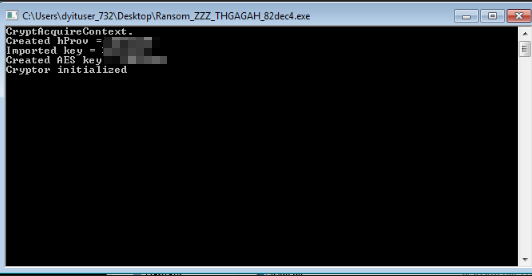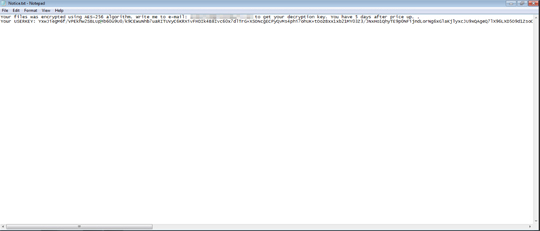Ransom_ZZZ.THGAGAH
Trojan-Ransom.Win32.Cryptor.bui (Kaspersky) , Trojan:Win32/Tiggre!rfn (Microsoft)
Windows


Threat Type: Ransomware
Destructiveness: No
Encrypted: No
In the wild: Yes
OVERVIEW
This Ransomware arrives on a system as a file dropped by other malware or as a file downloaded unknowingly by users when visiting malicious sites.
It drops files as ransom note.
TECHNICAL DETAILS
Arrival Details
This Ransomware arrives on a system as a file dropped by other malware or as a file downloaded unknowingly by users when visiting malicious sites.
Installation
This Ransomware drops the following files:
- {Current Malware Path}\bat.bat
- {Encrypted File Directory}\Notice.txt
It adds the following mutexes to ensure that only one of its copies runs at any one time:
- gcc-shmem-tdm2-mutex_global_shmem
- gcc-shmem-tdm2-global_lock_spinlock
- gcc-shmem-tdm2-use_fc_key
- gcc-shmem-tdm2-sjlj_once
- gcc-shmem-tdm2-once_global_shmem
- gcc-shmem-tdm2-once_obj_shmem
- gcc-shmem-tdm2-_pthread_tls_once_shmem
- gcc-shmem-tdm2-_pthread_tls_shmem
- gcc-shmem-tdm2-mtx_pthr_locked_shmem
- gcc-shmem-tdm2-mutex_global_static_shmem
- gcc-shmem-tdm2-mxattr_recursive_shmem
- gcc-shmem-tdm2-pthr_root_shmem
- gcc-shmem-tdm2-idListCnt_shmem
- gcc-shmem-tdm2-idListMax_shmem
- gcc-shmem-tdm2-idList_shmem
- gcc-shmem-tdm2-idListNextId_shmem
- gcc-shmem-tdm2-fc_key
- gcc-shmem-tdm2-_pthread_key_lock_shmem
- gcc-shmem-tdm2-cond_locked_shmem_rwlock
- gcc-shmem-tdm2-rwl_global_shmem
- gcc-shmem-tdm2-_pthread_key_sch_shmem
- gcc-shmem-tdm2-_pthread_key_max_shmem
- gcc-shmem-tdm2-_pthread_key_dest_shmem
Other Details
This Ransomware does the following:
- It deletes shadow copies by executing the following command:
- vssadmin delete shadows /all /quiet
- After encrypting the files it will drop and execute a bat file that will be used to delete itself

- It encrypts files in all fixed, remote and removable drives.
- Shows the following:

Ransomware Routine
This Ransomware avoids encrypting files found in the following folders:
- C:\Windows
It appends the following extension to the file name of the encrypted files:
- .zzz12
It drops the following file(s) as ransom note:
- {Encrypted File Directory}\Notice.txt

SOLUTION
Step 1
Before doing any scans, Windows XP, Windows Vista, and Windows 7 users must disable System Restore to allow full scanning of their computers.
Step 2
Note that not all files, folders, and registry keys and entries are installed on your computer during this malware's/spyware's/grayware's execution. This may be due to incomplete installation or other operating system conditions. If you do not find the same files/folders/registry information, please proceed to the next step.
Step 3
Restart in Safe Mode
Step 4
Search and delete this file
- {Current Malware Path}\bat.bat
- {Encrypted File Directory}\Notice.txt
Step 5
Restart in normal mode and scan your computer with your Trend Micro product for files detected as Ransom_ZZZ.THGAGAH. If the detected files have already been cleaned, deleted, or quarantined by your Trend Micro product, no further step is required. You may opt to simply delete the quarantined files. Please check this Knowledge Base page for more information.
Step 6
Restore encrypted files from backup.
Did this description help? Tell us how we did.

